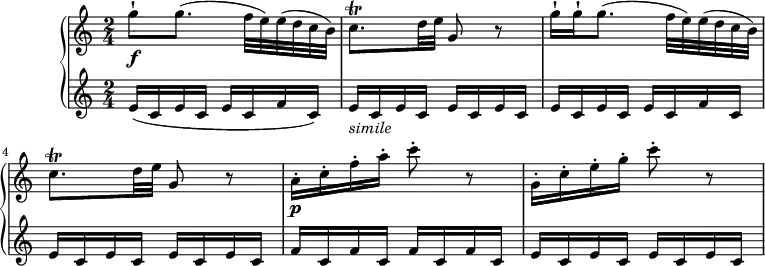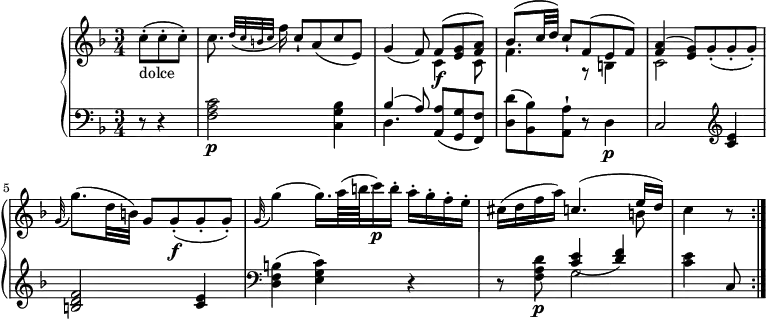Sonate pour piano no 10 de Mozart
La Sonate pour piano no 10 en do majeur, K. 330/300h, de Wolfgang Amadeus Mozart, est la première du cycle de trois sonates KV 330–331-332. Elle a été composée en 1783 quand Mozart avait 27 ans. Elle a été publiée avec les deux autres en 1784 par Artaria. L'autographe se trouve à la Bibliothèque Jagellonne.
| Sonate pour piano no 10 en do majeur K. 330/300h Sonate Nr. 10 in C-Dur | |
 Mozart, en 1777 | |
| Genre | Sonate pour piano |
|---|---|
| Nb. de mouvements | 3 |
| Musique | Wolfgang Amadeus Mozart |
| Durée approximative | Env. 20 minutes |
| Dates de composition | 1783 |
| Partition autographe | Bibliothèque Jagellonne, publiée par Artaria en 1784 |
Analyse
La sonate est en trois mouvements :
- Allegro moderato, en do majeur, à

 , 150 mesures, 2 sections répétées deux fois (première section : mesures 1 à 58 et seconde section : mesures 59 à 150) - partition
, 150 mesures, 2 sections répétées deux fois (première section : mesures 1 à 58 et seconde section : mesures 59 à 150) - partition - Andante cantabile, en fa majeur, à

 , 64 mesures - partition
, 64 mesures - partition - Allegretto, en do majeur, à

 , 171 mesures, 2 sections répétées deux fois (première section : mesures 1 à 68 et seconde section : mesures 69 à 171) - partition
, 171 mesures, 2 sections répétées deux fois (première section : mesures 1 à 68 et seconde section : mesures 69 à 171) - partition
- Durée de l'interprétation : environ 20 minutes
| Fichier audio | |
| Allegro moderato, par Barbara Semenchuk (2013) | |
| Fichier audio | |
| Andante cantabile, par Johannes Volker Schmidt (2009) | |
Introduction de l'Allegro moderato :

Introduction de l'Andante cantabile :

Introduction de l'Allegretto :
![\version "2.18.2"
\header {
tagline = ##f
}
upper = \relative c'' {
\tempo "Allegretto"
\key c \major
\time 2/4
\tempo 4 = 80
e8. \p (f32 g c,8) <b d>-!
<b d> ( \grace f'32 <c e>8) <b d>4
e8. (f32 g c,8) <b d>
<d f> (<c e> \trill ) <b d>4
f'8. (g32 f e8) e-!
a8. (b32 c g8) g-!
g16 (f) f (d) f (e) e (c)
cis (d e d c b a g)
}
lower =\relative c' {
\clef "bass"
\key c \major
\time 2/4
r8 c, \p e g
c c, g' g,
r8 c [e g]
c c, g' g,
a' (c g c f, c' e, c')
r <b g'> r <c g'>
<g b>4 r
}
\score {
\new PianoStaff <<
\new Staff = "upper" \upper
\new Staff = "lower" \lower
>>
\layout {
\context {
\Score
\remove "Metronome_mark_engraver"
}
}
\midi { }
}](https://img.franco.wiki/i/7e08f31644b03583f295f7226e38a4c3.png.webp)
Notes et références
- (en) Cet article est partiellement ou en totalité issu de l’article de Wikipédia en anglais intitulé « Piano Sonata No. 10 (Mozart) » (voir la liste des auteurs).
Liens externes
- (de) Partition et appareil critique dans la Neue Mozart-Ausgabe
- Fac-similé de la page 5
- Ressources relatives à la musique :
Bibliographie
- Jean Massin et Brigitte Massin, Mozart, Paris, Fayard, coll. « Les indispensables de la musique », , 1270 p. (ISBN 2-213-00309-2), p. 820.
- Guy Sacre, La musique de piano : Dictionnaire des compositeurs et des œuvres J-Z, t. 2, Paris, Robert Laffont, coll. « Bouquins », , 2998 p. (ISBN 2-221-08566-3), p. 1995.
- François-René Tranchefort, Guide de la musique de piano et de clavecin, Paris, Fayard, coll. « Les indispensables de la musique », , 484e éd. (1re éd. 1987), 869 p. (ISBN 2-213-01639-9), p. 543.
- Bertrand Dermoncourt (direction), Tout Mozart : Encyclopédie de A à Z, Paris, Robert Laffont, coll. « Bouquins », , 1093 p. (ISBN 2-221-10669-5), p. 865.
Cet article est issu de wikipedia. Text licence: CC BY-SA 4.0, Des conditions supplémentaires peuvent s’appliquer aux fichiers multimédias.